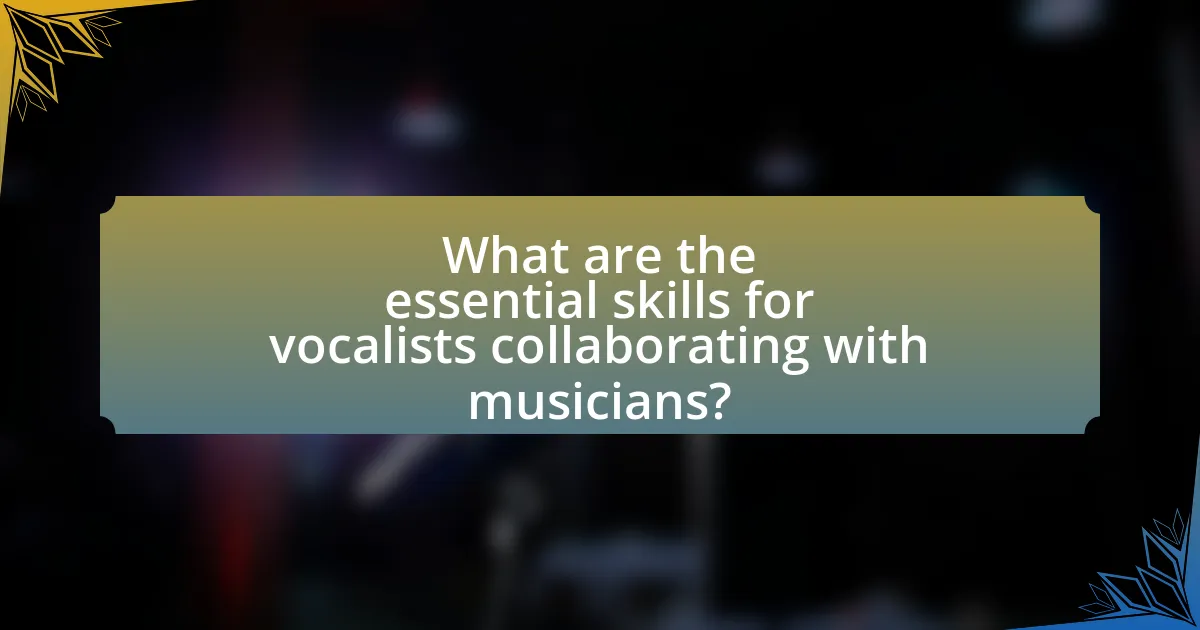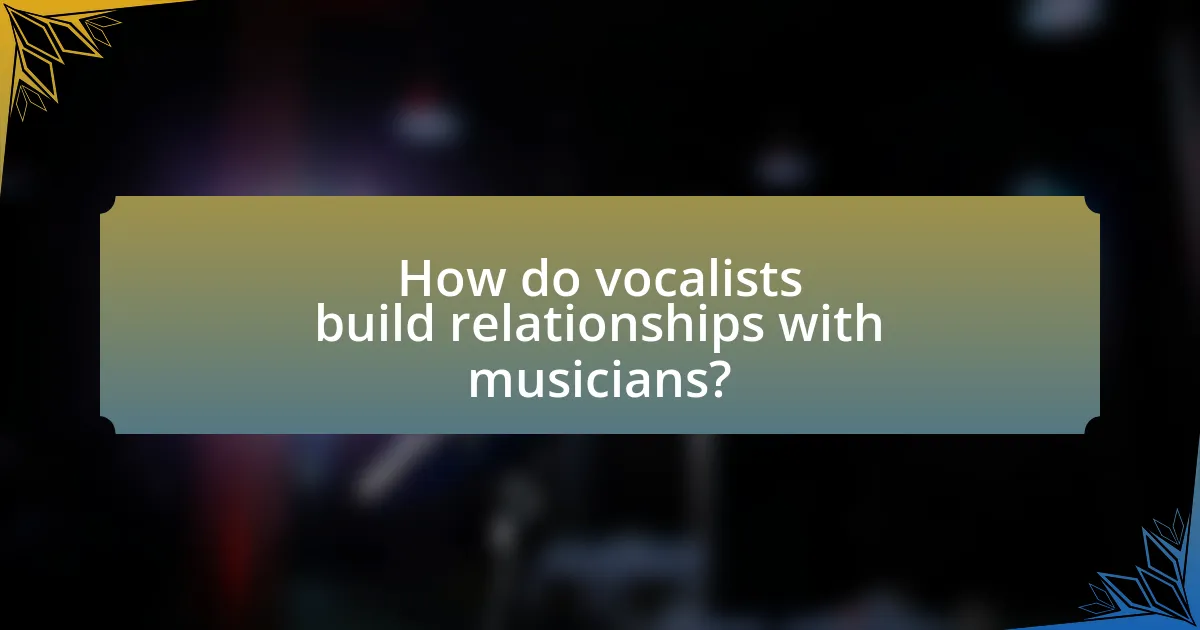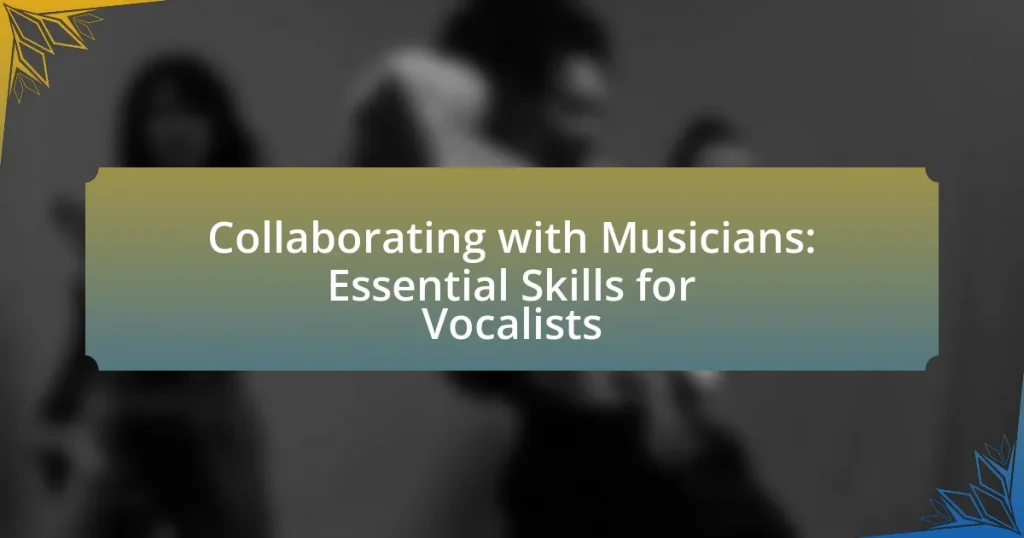The article focuses on the essential skills vocalists need for effective collaboration with musicians, emphasizing strong communication, adaptability, and musicality. It outlines techniques for vocalists to communicate effectively, including active listening and clear verbal cues, while also highlighting the importance of adaptability in adjusting to different musical genres. Additionally, the article discusses the significance of understanding music theory, building relationships, and establishing trust with collaborators. Practical tips for preparation, goal-setting, and overcoming common challenges in musical collaboration are also provided, offering a comprehensive guide for vocalists aiming to enhance their collaborative efforts.

What are the essential skills for vocalists collaborating with musicians?
The essential skills for vocalists collaborating with musicians include strong communication, adaptability, and musicality. Effective communication allows vocalists to convey their ideas and understand the vision of the musicians they work with, fostering a collaborative environment. Adaptability is crucial as vocalists must adjust their style and approach to fit different genres and the preferences of their collaborators. Musicality encompasses a deep understanding of rhythm, melody, and harmony, enabling vocalists to blend seamlessly with instrumentalists. These skills are supported by the fact that successful collaborations often lead to innovative musical outcomes, as seen in numerous genre-blending projects in the music industry.
How can vocalists effectively communicate with musicians?
Vocalists can effectively communicate with musicians by using clear verbal cues, body language, and active listening. Clear verbal cues involve articulating specific musical ideas, such as dynamics, tempo, and phrasing, which helps musicians understand the vocalist’s vision. Body language, including gestures and facial expressions, reinforces these verbal cues and conveys emotions that may not be expressed through words alone. Active listening allows vocalists to respond to musicians’ input, fostering a collaborative environment where ideas can be exchanged freely. Research indicates that effective communication in musical collaboration enhances overall performance quality and creativity, as seen in studies on ensemble dynamics and group cohesion.
What are the key communication techniques vocalists should use?
Vocalists should use active listening, clear verbal communication, and non-verbal cues as key communication techniques. Active listening allows vocalists to fully engage with other musicians, ensuring they understand musical cues and emotional nuances. Clear verbal communication helps articulate ideas, feedback, and intentions effectively, fostering collaboration. Non-verbal cues, such as body language and facial expressions, enhance the connection between vocalists and their collaborators, conveying emotions and intentions that words may not fully express. These techniques are essential for creating a cohesive musical experience and improving overall performance quality.
How does active listening enhance collaboration?
Active listening enhances collaboration by fostering mutual understanding and respect among team members. When individuals actively listen, they demonstrate engagement and validate each other’s contributions, which leads to a more cohesive working environment. Research indicates that effective communication, including active listening, can improve team performance by up to 25%, as it reduces misunderstandings and encourages open dialogue. This practice allows musicians to share ideas freely, leading to more innovative and creative outcomes in collaborative projects.
What role does adaptability play in musical collaboration?
Adaptability is crucial in musical collaboration as it allows musicians to adjust their styles, ideas, and approaches to create a cohesive sound. This flexibility fosters an environment where diverse musical influences can merge, enhancing creativity and innovation. For instance, a study published in the Journal of Music Psychology highlights that successful collaborations often stem from musicians’ ability to embrace change and respond to each other’s contributions, leading to more dynamic and engaging performances.
How can vocalists adjust their style to fit different genres?
Vocalists can adjust their style to fit different genres by modifying their vocal techniques, phrasing, and emotional delivery. For instance, in pop music, vocalists often use a bright, clear tone with catchy melodies, while in jazz, they may employ more improvisation and a relaxed, laid-back style. Additionally, country music often requires storytelling through a twangy vocal quality, whereas classical singing demands precise control and a focus on resonance. These adjustments are supported by the understanding that different genres have distinct stylistic conventions and audience expectations, which vocalists must recognize and adapt to in order to effectively convey the music’s essence.
Why is it important for vocalists to be open to feedback?
Vocalists must be open to feedback to enhance their performance and vocal technique. Feedback provides critical insights that help vocalists identify areas for improvement, refine their skills, and adapt their style to better connect with audiences. Studies show that musicians who actively seek and incorporate feedback experience faster growth and development in their craft, leading to more successful collaborations and performances. For instance, a survey conducted by the National Association of Teachers of Singing found that 85% of vocalists reported significant improvement in their abilities when they engaged with constructive criticism from peers and instructors.
What are the benefits of understanding music theory for vocalists?
Understanding music theory provides vocalists with essential skills that enhance their musicality and collaboration with other musicians. By grasping concepts such as scales, chords, and rhythm, vocalists can improve their ability to interpret music accurately and communicate effectively with instrumentalists. This knowledge allows them to make informed decisions about phrasing, dynamics, and harmony, which are crucial for delivering compelling performances. Furthermore, studies indicate that musicians with a solid foundation in music theory are better equipped to improvise and adapt during live performances, leading to more dynamic and engaging musical experiences.
How does knowledge of music theory improve collaboration?
Knowledge of music theory significantly improves collaboration among musicians by providing a common language and framework for communication. When musicians understand concepts such as scales, chords, and rhythm, they can more effectively share ideas, make decisions, and create cohesive musical pieces together. For instance, a study published in the Journal of Music Theory demonstrates that musicians who possess a solid grasp of music theory are better equipped to engage in improvisation and arrangement, leading to more productive and harmonious collaborations. This shared understanding minimizes misunderstandings and enhances the overall creative process, allowing for a more fluid exchange of musical ideas.
What specific music theory concepts should vocalists learn?
Vocalists should learn specific music theory concepts such as scales, intervals, chord progressions, and rhythm. Understanding scales allows vocalists to navigate melodies and improvise effectively, while knowledge of intervals helps them identify the distance between notes, crucial for pitch accuracy. Chord progressions provide context for melodies, enabling vocalists to harmonize and collaborate with instrumentalists. Rhythm comprehension is essential for timing and phrasing, ensuring that vocalists stay in sync with the music. These concepts are foundational for effective collaboration with musicians, as they enhance communication and musicality in ensemble settings.

How do vocalists build relationships with musicians?
Vocalists build relationships with musicians through effective communication, collaboration, and mutual respect. By engaging in open dialogue about artistic vision and expectations, vocalists can establish a foundation of trust and understanding with musicians. Collaborative efforts, such as co-writing songs or rehearsing together, further strengthen these relationships, allowing both parties to contribute creatively and develop a shared musical identity. Additionally, showing appreciation for musicians’ skills and contributions fosters a positive environment, enhancing the overall collaboration. Research indicates that successful musical partnerships often stem from strong interpersonal connections, highlighting the importance of emotional intelligence and social skills in these interactions.
What strategies can vocalists use to network with musicians?
Vocalists can network with musicians by actively participating in local music events and online platforms. Engaging in open mic nights, jam sessions, and music festivals allows vocalists to meet other musicians in a collaborative environment. Additionally, utilizing social media platforms like Instagram, Facebook, and LinkedIn enables vocalists to connect with musicians, share their work, and engage in discussions about music. Research indicates that 70% of musicians find collaboration opportunities through social media interactions, highlighting its effectiveness. Furthermore, joining music-related groups or forums can facilitate connections and provide opportunities for collaboration, as these platforms often encourage networking among members.
How can social media be leveraged for networking?
Social media can be leveraged for networking by actively engaging with industry professionals and peers through platforms like Instagram, LinkedIn, and Twitter. These platforms allow musicians and vocalists to showcase their work, connect with collaborators, and participate in discussions relevant to their field. For instance, a study by the Pew Research Center found that 72% of adults use social media, making it a vital tool for reaching a broad audience and establishing professional relationships. By sharing content, commenting on posts, and joining relevant groups, vocalists can enhance their visibility and create opportunities for collaboration within the music industry.
What are effective ways to approach musicians for collaboration?
Effective ways to approach musicians for collaboration include personalizing your outreach, demonstrating genuine interest in their work, and clearly articulating the benefits of collaboration. Personalizing outreach involves researching the musician’s style and previous projects, which shows respect and understanding of their artistry. Demonstrating genuine interest can be achieved by referencing specific songs or performances that resonate with you, creating a connection. Clearly articulating the benefits of collaboration means outlining how the partnership can enhance both parties’ creative goals, potentially leading to a mutually beneficial outcome. These strategies are supported by successful collaborations in the music industry, where artists often cite personalized communication and shared vision as key factors in their partnerships.
Why is trust important in musician-vocalist collaborations?
Trust is crucial in musician-vocalist collaborations because it fosters open communication and creative freedom. When musicians and vocalists trust each other, they are more likely to share ideas, experiment with different styles, and provide constructive feedback, which enhances the overall quality of the collaboration. Research indicates that trust leads to higher levels of collaboration satisfaction and better artistic outcomes, as seen in studies where successful musical partnerships often cite mutual respect and trust as foundational elements.
How can vocalists establish trust with their collaborators?
Vocalists can establish trust with their collaborators by demonstrating reliability and open communication. Reliability is shown through consistent attendance at rehearsals, meeting deadlines for song submissions, and delivering quality performances. Open communication involves sharing ideas, providing constructive feedback, and being receptive to others’ input, which fosters a collaborative environment. Research indicates that effective communication and reliability are key factors in successful musical collaborations, as they enhance mutual respect and understanding among team members.
What are common pitfalls that can damage trust in collaborations?
Common pitfalls that can damage trust in collaborations include lack of communication, unmet expectations, and failure to acknowledge contributions. Lack of communication can lead to misunderstandings, as studies show that 70% of workplace failures are attributed to poor communication. Unmet expectations arise when collaborators do not clarify their roles or objectives, resulting in frustration and resentment. Additionally, failure to acknowledge contributions can create feelings of undervaluation among team members, which research indicates can significantly decrease motivation and trust.

What practical tips can vocalists apply when collaborating with musicians?
Vocalists can enhance collaboration with musicians by actively listening to their contributions and being open to feedback. This practice fosters a supportive environment where ideas can flow freely, leading to more cohesive musical arrangements. Additionally, vocalists should communicate their artistic vision clearly, ensuring that all collaborators understand the intended direction of the project. Establishing a mutual respect for each other’s roles and expertise is crucial, as it encourages creativity and innovation. Furthermore, rehearsing together regularly allows vocalists and musicians to develop a tighter musical synergy, ultimately improving the overall performance quality.
How can vocalists prepare for a collaborative session?
Vocalists can prepare for a collaborative session by practicing their parts thoroughly and understanding the material to be performed. This preparation includes familiarizing themselves with the song structure, lyrics, and any harmonies or vocal arrangements involved. Additionally, vocalists should communicate with their collaborators to discuss artistic vision and expectations, ensuring alignment on the overall sound and style. Research indicates that effective communication and preparation enhance group cohesion and performance quality, as seen in studies on musical collaboration dynamics.
What should vocalists do before the first rehearsal?
Vocalists should prepare their vocal warm-ups and review the material to be rehearsed before the first rehearsal. Engaging in vocal warm-ups helps to ensure vocal health and readiness, while reviewing the material allows vocalists to familiarize themselves with the music and lyrics, enhancing their performance. Studies indicate that proper vocal warm-ups can improve vocal performance and reduce the risk of strain, making this preparation essential for effective collaboration with musicians.
How can vocalists set clear goals for collaboration?
Vocalists can set clear goals for collaboration by defining specific outcomes they wish to achieve, such as improving vocal techniques, expanding their musical repertoire, or enhancing stage presence. By articulating these objectives, vocalists can align their efforts with collaborators, ensuring that everyone is working towards a common purpose. Research indicates that goal-setting enhances performance and motivation; for instance, a study published in the Journal of Applied Psychology found that specific and challenging goals lead to higher performance levels compared to vague or easy goals. Therefore, vocalists should communicate their goals openly with collaborators to foster a productive and focused working environment.
What are some common challenges vocalists face in collaboration?
Vocalists commonly face challenges such as communication barriers, differing artistic visions, and issues with blending vocal styles during collaboration. Communication barriers can arise from misunderstandings or lack of clarity in conveying ideas, which can hinder the creative process. Differing artistic visions may lead to conflicts over song direction, arrangement, or performance style, making it difficult to reach a consensus. Additionally, blending vocal styles can be challenging when vocalists have distinct techniques or tonal qualities, potentially resulting in a lack of cohesion in the final product. These challenges are frequently reported in collaborative music projects, highlighting the importance of effective communication and adaptability among vocalists.
How can vocalists overcome creative differences with musicians?
Vocalists can overcome creative differences with musicians by fostering open communication and establishing a collaborative environment. This involves actively listening to each other’s ideas, expressing their own perspectives clearly, and finding common ground on artistic choices. Research indicates that effective collaboration often hinges on mutual respect and understanding, which can lead to innovative solutions that satisfy both parties. For instance, a study published in the Journal of Music Psychology highlights that successful musical collaborations often result from a balance of assertiveness and receptiveness among team members, allowing for diverse creative inputs while maintaining a cohesive vision.
What strategies can help resolve conflicts during collaboration?
Effective strategies to resolve conflicts during collaboration include active listening, open communication, and establishing clear roles. Active listening allows team members to fully understand each other’s perspectives, reducing misunderstandings. Open communication fosters an environment where individuals feel safe to express their concerns and ideas, which can lead to collaborative problem-solving. Establishing clear roles ensures that everyone knows their responsibilities, minimizing overlap and potential conflicts. Research indicates that teams with defined roles and open communication channels experience 25% fewer conflicts, highlighting the effectiveness of these strategies in collaborative settings.
What best practices should vocalists follow for successful collaborations?
Vocalists should prioritize clear communication, mutual respect, and flexibility for successful collaborations. Clear communication ensures that all parties understand their roles, expectations, and creative visions, which is essential for a cohesive outcome. Mutual respect fosters a positive working environment, allowing each vocalist to contribute their unique strengths without conflict. Flexibility is crucial as it enables vocalists to adapt to different styles and ideas, enhancing the collaborative process. Research indicates that effective communication and respect among team members significantly improve project outcomes in creative fields, highlighting the importance of these practices in musical collaborations.















